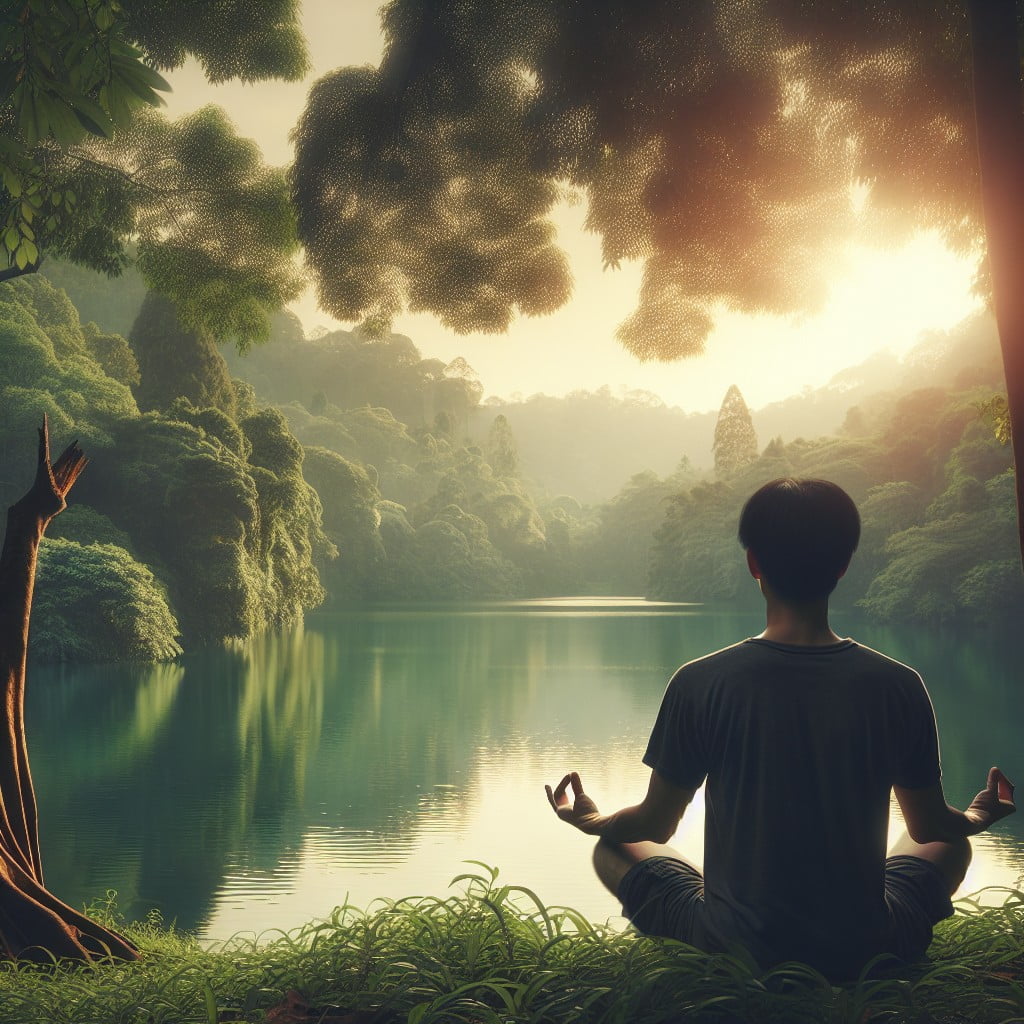Navigate the journey to tranquility using meditation, because unlocking inner peace significantly enhances life’s quality.
Embarking on a journey to find inner peace through meditation can be transformative. This practice, rooted in ancient traditions, can help you cultivate a sense of calm, balance, and tranquility in your daily life.
By focusing on your breath, letting go of intrusive thoughts, and becoming more mindful of your body, you can achieve a state of inner peace. This article will guide you step-by-step on how to meditate for inner peace, detailing techniques and tips to enhance your practice, and highlighting the scientifically-backed benefits of meditation.
Whether you’re a beginner or an experienced practitioner, this comprehensive guide will provide you with valuable insights to deepen your meditation practice and find the inner peace you’re seeking.
Key takeaways:
- Inner peace is being comfortable with oneself and not at war with one’s thoughts and emotions.
- Inner peace involves a sense of harmony and balance in mind, body, and spirit.
- Inner peace is about being fully present and engaged in the current moment.
- Inner peace requires accepting things as they are and building resilience.
- True inner peace is independent of external circumstances.
Understanding the Concept of Inner Peace

Inner peace, a deep sense of tranquility, arises when the mind is calm and quiet. It’s a state of serenity that transcends the chaotic whirl of thoughts, worries, and stresses, functioning as a sanctuary where we can retreat to, even amidst the hustle and bustle of daily life.
Here are some key points:
- Inner peace is being comfortable with oneself, having an integrated sense of self, and not being in a war with your own thoughts and emotions.
- It relates to a sense of harmony where the mind, body, and spirit align, promoting a balance that is unaffected by external conditions.
- Inner peace is a feeling of being completely present and fully engaged with life in the current moment, free from lingering regrets about the past or anxieties about the future.
- It involves having a sense of power and control over your life, accepting things as they are, and building a reservoir of positivity and resilience to face life’s challenges.
- True inner peace is independent of external circumstances, revealing itself more during challenging times rather than in the absence of problems.
Remember, inner peace may seem elusive, but it’s always within you, waiting to be discovered, nurtured, and treasured.
Reasons to Find Inner Peace Through Meditation

Meditation, a tool steeped in ancient practices, has profound effects that extend beyond calming an agitated mind.
1. Stress Reduction: The hustle and bustle of daily life can lead to chronic stress. By meditating, the mind is trained to focus, reducing the cluttering thoughts which often cause stress.
2. Improved Focus: During meditation, you learn to centralize your attention, which in turn significantly enhances concentration levels in other facets of life.
3. Emotional Well-being: Regular meditation can instill a sense of calm and happiness. It helps to lower anxiety levels, reducing feelings of depression, and enhancing overall mental health.
4. Increased Self-awareness: Meditation allows you to create a deeper understanding of yourself and your inner workings, helping to grow into your best self.
5. Enhanced Sleep: The tranquility that meditation brings helps in dealing with insomnia, guiding the mind and body into a peaceful state conducive to sleep.
6. Fostering Kindness: Some forms of meditation cultivate positive emotions, encouraging a more compassionate attitude towards others and oneself.
Benefits of Using Meditation to Find Inner Peace

Engaging in meditation for inner peace unsurprisingly presents a bundle of benefits tailored to personal wellbeing.
Firstly, it aids in stress reduction. Meditation activates a state of rest in your body, offsetting the stress response that often leads to feelings of anxiety and overwhelm.
Meditation also increases self-awareness. As one focuses on quieting the mind, an increased awareness of the self naturally occurs. This heightened consciousness promotes a clearer understanding of thoughts and behaviors, fostering emotional health.
In addition, practicing regular meditation improves focus and attention. When meditating, individuals learn to control where their attention goes, this advancement often translates into heightened concentration in daily activities.
Moreover, meditation has been linked with improved sleep. The peace derived from meditation often aids in falling asleep faster and experiencing a deeper, more satisfying night’s rest.
Lastly, meditation often inspires a kinder, more compassionate disposition towards others. With increased self-awareness comes better understanding of emotions and actions that in turn foster empathy and compassion, leading to improved relationships.
Making meditation a regular part of life can thus lead to holistic transformations that go beyond ephemeral moments of peace, setting the foundations of a more serene existence.
Sit Comfortably

When embracing meditation, comfort is paramount. Start by selecting a quiet and serene spot. This could be an uncluttered room, a garden, or any place where you feel calm. Choose a position which naturally lends itself to stillness, such as sitting cross-legged on a cushion, chair, or a yoga mat. Keep your spine straight yet relaxed, fostering a sense of stability.
Your knees should ideally be lower than your hips. Rest your hands gently on your lap; you could place one upon the other or let them touch your knees. Remember, the essence here is to be at ease yet alert, to align with the balance meditation promotes.
Once in the position, close your eyes but stay awake. Neck and shoulders should be stress-free, and your mouth slightly open. This position guarantees unrestricted breathing, foundational to meditation.
Tweaks are allowable. With time, you’ll find your unique comfort spot within these basic guidelines. Here, every minor adjustment could lead to major leaps in your journey of inner peace.
Adjusting the Body and the Mind for Meditation
It’s crucial to find a quiet, serene spot where you can get started, free from interruptions or noise. The key is to create an inviting, restful setting that encourages mental tranquility.
Next focus on your posture, ideally, sit on the floor or a cushion with a straight back, which promotes effective breathing. Align your body to where your head, neck and spine fall into a straight line.
Lay the groundwork for stillness by closing your eyes and taking slow, deliberate breaths. Savor the calming rhythm of your inhalations and exhalations. Keep your focus gently on the breath—the perfect anchor for your attention.
Remember, it’s about quieting the chatter in your mind. Aim not to control your thoughts, but rather notice them. Observe your thoughts as fleeting, like clouds passing in the sky instead of attaching significance or judgment to them.
With practice, this alignment of body and mind serves as the catalyst to deeper meditation and fuller inner peace.
Let Yourself Enjoy the Feeling of Peacefulness
Just like the sun’s radiance behind a cloud, peacefulness always resides within you. Engaging with that tranquility during meditation is profoundly rewarding.
Here’s how:
- 1. Invite Calm: Release all tensions and thoughts. Imagine them floating away like clouds, leaving behind a clear, serene sky.
- 2. Breathe Right: Focus on your breathing pattern. Inhale positivity and calmness; exhale any internal disturbances or stresses you might be feeling.
- 3. Observe and Accept: Acknowledge any physical sensations or thoughts without judgment. Peacefulness doesn’t mean the absence of thoughts, but maintaining an unattached observer’s perspective.
- 4. Harness the Power of Now: Engage fully in the present moment. This ‘now’ focused approach helps us connect more deeply with our inner peace.
- 5. Embrace Gratitude: Even during meditation, recognising and appreciating life’s blessings can elevate feelings of peacefulness.
Remember, just as ripples calm on a quiet pond, the mind too will slip into a state of peace if allowed to simply be. Take this chance to truly connect with that inherent stillness within.
Maintain Soft Awareness of the Center of the Body During Meditation
Awareness of the body’s center, while meditating, cultivates the ability to anchor oneself in the present moment and to connect with the innate state of tranquility. It is essential to keep the focus gentle, embodying a soft awareness, not a rigorous concentration.
Let’s dive into a few integral practices to achieve this:
- 1. Try imagining a small gentle ball of light at the center of your abdomen; this is often considered the body’s energetic center.
- 2. As you breathe in, imagine the ball expanding slightly, drawing in peace and calm. As you breathe out, see it shrinking back, radiating these feelings throughout your body.
- 3. Whenever your mind starts to wander, bring it back gently to the ball and your breath, like a bird returning to its nest.
- 4. Avoid forcing your focus; let it be light and gentle. It is a challenging balance but totally achievable with practice.
- 5. Practice consistently. Building this mindful habit takes time, but the rewards it brings are unparalleled.
Remember, there isn’t a ‘right’ or a ‘wrong’ in this process. It’s about cultivating a compassionate understanding of oneself, enriching the entire meditative journey. You will soon find yourself feeling grounded and obtaining a sense of inner peace.
Considerations to Prepare and Select Before Starting the Meditation Session
Before diving into the meditation practice, a few considerations can make the session more fruitful. Physical comfort is vital: select a quiet location, free of distractions, accommodating a comfortable seated position. Cushions or yoga mats can be used for added comfort. Clothing should be loose and breathable.
Deciding the time of the day is also essential. While some prefer early morning sessions when the mind is fresh, others find convenience and tranquility in evening sessions. Be consistent in your timetable and set realistic expectations. Start with brief sessions, gradually lengthening the duration as comfort and concentration improve.
Choosing the appropriate meditation technique influences your journey towards inner peace. Guided meditations can be useful for beginners, while others might prefer silent meditation or mindfulness techniques. Selection depends on personal comfort and individualistic spiritual goals.
Prepare by setting an intention for the practice. It’s not about expecting results, but being open and compassionate towards oneself. This mindset imbues the meditation with purpose, enhancing its potential to foster inner peace. Lastly, always remember, this is your journey – make it personal, make it matter.
Spreading the Peace Energy Through Meditation
Feeling tranquility within is rewarding, but spreading this peaceful energy beyond yourself exponentially magnifies its benefits. When your mind is calm and your heart radiates positivity, it automatically impacts those around you.
1. Practice compassion: Use the tranquility found in meditation to feel for others. The calmness enables us to understand their feelings better, fostering empathy.
2. Encourage collective meditation: Invite friends or family to meditate with you. Shared meditative experiences often lead to a collective sense of peace.
3. Be a pillar of strength: Your newfound peace and composure will provide a safe harbor for those grappling with stress around you.
4. Foster a harmonious environment: Displaying your inner calm tends to influence others, helping to create a balanced, serene atmosphere.
5. Lead by example: Living in a mindful and calm manner can inspire others to seek the same peaceful existence.
Remember, your peaceful energy can bring about change, and sharing this peace can lead to a more harmonious world.
Maintaining Inner Peace Post-Meditation
After a tranquil meditation session, maintaining the achieved calm can be the real challenge amid the hustle and bustle of everyday life. The following points can fortify your foundation for sustaining inner peace:
1. Making Meditation Daily Practice: Consistency is key. A routine of daily meditation instills a habit of calm that can be tapped into during stressful situations.
2. Conscious Breathing: Practicing mindfulness can prove beneficial in maintaining peace. Routinely notice your breathing, its rate, depth, and quality can help anchor yourself in the present moment, reducing stress.
3. Utilize a Peaceful Persona: Try to carry the meditation experience into everyday life. Let the calm of your meditative state influence your responses during the day.
4. Mindful Actions: Whether it’s an office task or daily chores, performing tasks with complete awareness and mindfulness keeps you present, and prevent getting overwhelmed.
5. Avoid Overstimulation: Modern life is full of distractions that can unsettle the peace. Make an effort to limit these disturbances to retain your tranquility.
6. Nature’s Embrace: Bring nature into your life through walks, plants, or the simple act of gazing at the stars. Nature has a serene influence that can help you maintain your internal peace.
7. Sunshine and Exercise: Sunlight promotes serotonin production, a hormone that boosts mood and promotes calm. Exercise, on the other hand, can channel your energy, reducing tension.
These tips can be instrumental in carrying the peace found during meditation throughout your day and life.
FAQ
Can you find peace through meditation?
Indeed, inner peace can be attained by practicing meditation, specifically through calming the mind to connect with the present moment.
How can one achieve mental equanimity through consistent meditation?
One can achieve mental equanimity through consistent meditation by developing focused attention and calming the mind which enhances emotional balance and facilitates understanding of thoughts and feelings.
What techniques can be employed to evoke a sense of tranquility during meditation?
Using mindfulness techniques such as body scan mediations, deep breathing exercises, visualization, and focusing on the sensation of breathing can help evoke a sense of tranquility during meditation.
What role does mindfulness play in actualizing inner peace through meditation?
Mindfulness plays a crucial role in actualizing inner peace through meditation as it cultivates awareness of the present moment, enabling individuals to detach from past regrets and future anxieties, thereby fostering a state of tranquility.